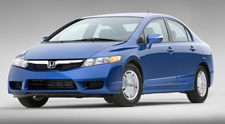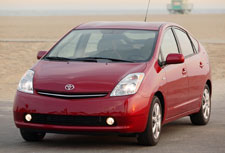Alternate Realities
Hybrid cars are the first wave of the future -- and the second wave is on its way
Necessity, as they say, is the mother of invention.
And in these days of uncertain gas prices and economic unease, necessity may need to get pretty inventive indeed. Auto showrooms have seen a drop-off in visitors, while sales of the once cachet-laden giant SUVs have nosedived and thrifty cars that drink gas by the sip instead of the guzzle have found themselves the belles of the ball.

Honda Civic Hybrid
So the buzz these days is definitely around hybrids, plug-in electric cars and fuel-cell vehicles. The latter two are still around the corner in terms of availability, while hybrids have firmly established themselves as the economical and ecological transportation of choice.
Of course, not all hybrids are created equal — it’s not clear that the world really needed a hybrid version of Cadillac’s behemoth Escalade SUV. Sure, 20 mpg in the city is an improvement over the gasoline-only version’s 12 mpg city — interestingly there’s little difference in highway driving, with the hybrid rated at 21 mpg and the standard at 19 mpg — but that’s grading on a sliding scale.
Back among the more traditionally sized hybrids, I recently spent some time in two of the mainstays of the hybrid market — the Toyota Prius and Honda Civic.
The Prius is the poster boy for hybrids with its distinctive exterior styling and somewhat quirky cabin. Front and center of the Prius dashboard is still dominated by the videoscreen that provides moment-by-moment information on how much electricity the car is generating and using, and what your mileage is as a result.
Most drivers are distracted by cell phones and CD players. Prius owners are distracted by their videogame-like system, obsessing over increasing their mileage by just one more. Naturally, I totally fall into that compulsive camp — it does make driving a daily adventure.
The Prius has changed little over the past few years. It’s not a luxury car, but it’s certainly comfortable. And priced under $25,000 it’s a good deal. If the Prius isn’t really your thing, Toyota has propagated their hybrid system across most of its models, including Lexus, so you have a big range of styles and prices to choose from.

Toyota Prius
Unlike the Prius, the Honda Civic Hybrid underplays its gas-electric heart — aside from the small ”hybrid” badge on the back of the car, there’s no indication of what’s under the hood. That’s a nice option for those who aren’t into conspicuous conservation.
Just as the exterior and interior stylings of the Civic Hybrid are essentially identical to the standard Civic — a good thing, since it’s a solid car all around — the driving experience differs little. It drives and sounds more like a standard gasoline powered car than does the Prius — the Civic is much less subtle when the gas engine powers down — the best approach for some types of drivers. The price, however, is similar — the model I tested priced out at just under $25K.
It’s easy to forget that Honda was an early player in the hybrid market with the funkily styled Insight, a tiny commuter car that played with the same ”futuristic” styling tropes as the Prius, but was a little ahead of its time. Honda announced this year that it’s reintroducinga new version of the Insight in spring 2009.
Perhaps unsurprisingly, it looks a lot like a Prius.
The Insight actually draws some of its styling cues from Honda’s longer-term alternative energy project, the fuel-cell powered FCX Clarity. Basically, the Clarity uses hydrogen to generate the electricity to power the car — the resulting emissions being just water. The Clarity is being produced in very limited numbers over the next three years, and judging from press releases you may need to be a celebrity to get your hands on one.
GM hopes to change the market with the introduction of the Chevrolet Volt, the first plug-and-charge car. The Volt, which is scheduled to debut in late 2010, differs from the current crop of hybrids by deriving all its power from an electric engine that will charge through a standard home outlet. If the charge depletes while driving — GM promises up to 40 miles of driving on a full charge — an on-board gasoline motor will charge the battery while driving.
GM is betting a lot of its future on the Volt technology and if it works as promised it could be a serious change to how we power our transportation.
Whether you’re looking to buy now or have your eye toward the near future, it’s clear that the market is reaching a tipping point for ultra-fuel efficient and alternate fuel vehicles. For car fanatics and everyday drivers alike, that’s good thing.
Support Metro Weekly’s Journalism
These are challenging times for news organizations. And yet it’s crucial we stay active and provide vital resources and information to both our local readers and the world. So won’t you please take a moment and consider supporting Metro Weekly with a membership? For as little as $5 a month, you can help ensure Metro Weekly magazine and MetroWeekly.com remain free, viable resources as we provide the best, most diverse, culturally-resonant LGBTQ coverage in both the D.C. region and around the world. Memberships come with exclusive perks and discounts, your own personal digital delivery of each week’s magazine (and an archive), access to our Member's Lounge when it launches this fall, and exclusive members-only items like Metro Weekly Membership Mugs and Tote Bags! Check out all our membership levels here and please join us today!




















